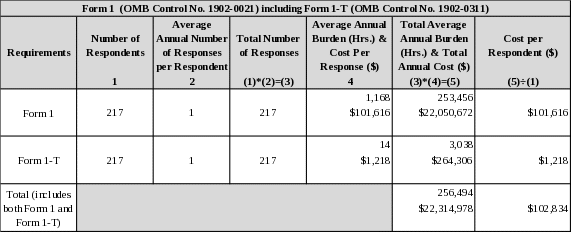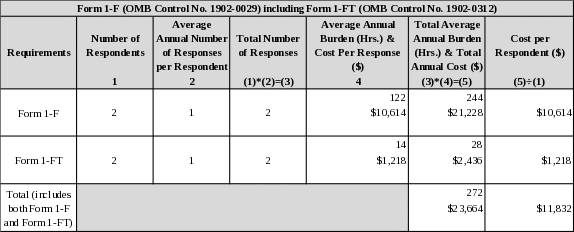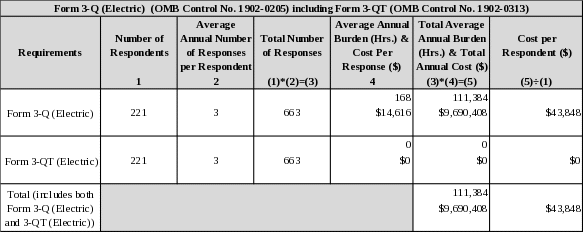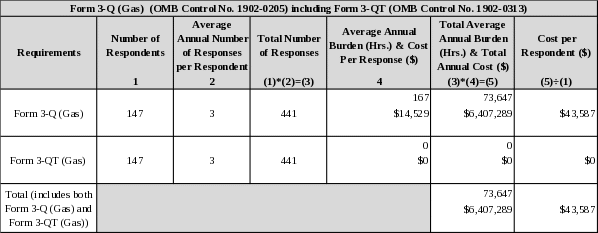Final 1_1F_3Q_Renewal supp. statement
Final 1_1F_3Q_Renewal supp. statement.docx
FERC Form 1-F, Annual Report for Nonmajor Public Utilities and Licensees
OMB: 1902-0029
FERC Form Nos. 1, 1T, 1-F, 1-FT, 3-Q (electric and natural gas) and 3-QT (electric and natural gas), Docket No. IC22-3-000, OMB Control Nos. 1902-0021, 1902-0029, 1902-0205, 1902-0311, 1902-0312, and 1902-0313
Consolidated Supporting Statement for
FERC Form Nos. 1, 1-F, and 3-Q (electric and natural gas)
The Federal Energy Regulatory Commission (Commission or FERC) requests the Office of Management and Budget (OMB) approve FERC Form Nos. 1, 1-F, and 3-Q (electric and gas) for three years.1 FERC Form 1T, 1-FT, and 3-QT are temporary information collection numbers that are going to be rolled into the FERC Form Nos. 1, 1-F, and 3-Q, respectively, but were used to collect the changes related to moving the FERC Form Nos. 1, 1-F, and 3-Q to XBRL format in 2019. After the requirements and burden of the FERC Form Nos. 1T, 1-FT, and 3-QT are incorporated into FERC Form Nos. 1, 1-F, and 3-Q and approved by OMB, the standalone “T” OMB Control Nos. are anticipated to be retired because they will be duplicative. There are no changes to the reporting requirements for the existing information collections other than consolidating the hours and requirements for the temporary information collection numbers into the permanent forms as follows:
FERC Form No. 1 (Annual Report of Major Electric Utilities, Licensees and Others; OMB Control No. 1902-0021), including the requirements of the FERC Form No. 1-T (OMB Control No. 1902-0311);
FERC Form No. 1-F (Annual Report for Nonmajor Public Utilities and Licensees; OMB Control No. 1902-0029), including the requirements of the FERC Form No. 1-FT (OMB Control No. 1902-0312); and
FERC Form No. 3-Q (Quarterly Financial Report of Electric Utilities, Licensees, and Natural Gas Companies; OMB Control No. 1902-0205), including the requirements of the FERC Form No. 3-QT (OMB Control No. 1902-0313)
Form No. 3-Q for natural gas entities
Form No. 3-Q for electric entities
CIRCUMSTANCES THAT MAKE THE COLLECTION OF INFORMATION NECESSARY
FERC Form Nos. 1, 1-F, and 3-Q. In accordance with sections 304 and 309 of the Federal Power Act (FPA) and section 10(a) of the Natural Gas Act (NGA), FERC is authorized to collect and record data to the extent it considers necessary, and to prescribe rules and regulations concerning accounts, records, and memoranda.
Under the existing regulations, FERC jurisdictional entities subject to its Uniform System of Accounts (USofA) must annually file with the Commission a complete set of financial statements, along with other selected financial and non-financial data through the submission of FERC Form Nos. 1 and 1-F. FERC Form No. 1 is a comprehensive financial and operating report submitted for electric rate regulation, market oversight analysis, and financial audits by Major electric utilities, licensees, and others. Major pertains to utilities and licensees that have, in each of the last three consecutive calendar years, sales or transmission services that exceed one of the following: (1) one million megawatt hours of total sales; (2) 100 megawatt hours of sales for resale; (3) 500 megawatt hours of power exchanges delivered; or (4) 500 megawatt hours of wheeling for others (deliveries plus losses).2
FERC Form No. 1-F is designed to collect financial and operational information from Nonmajor electric utilities and licensees. Nonmajor pertains to utilities and licensees that have total annual sales of 10,000 megawatt-hours or more in each of the last three consecutive years and that are not classified as Major.3
FERC Form No. 3-Q is a quarterly financial and operating report for rate regulation, market oversight analysis, and financial audits which supplements the (a) FERC Form Nos. 1 and 1-F for the electric industry, or the (b) FERC Form Nos. 2 and 2-A for the natural gas industry. FERC Form No. 3-Q is submitted for electric utilities and licensees reporting FERC Form Nos. 1 or 1-F and natural gas companies reporting FERC Form Nos. 2 or 2A.4
The Commission collects FERC Form Nos. 1, 1-F, and 3-Q as prescribed in Title 18 C.F.R. (Code of Federal Regulations) Parts 141.1, 141.2, 141.400, and 260.300. FERC Forms Nos. 1, 1-F, and 3-Q provide an informative picture of the jurisdictional entities’ financial conditions and other relevant data that are used by the Commission and the public in making economic judgments about the entity or its industry.
HOW, BY WHOM, AND FOR WHAT PURPOSE THE INFORMATION IS TO BE USED AND THE CONSEQUENCES OF NOT COLLECTING THE INFORMATION
FERC Form Nos. 1, 1-F, and 3-Q (electric). These forms provide information concerning a company’s current performance, compiled using the Commission’s USofA.5 The forms include a basic set of financial statements: Comparative Balance Sheet, Statement of Income, Statement of Retained Earnings, Statement of Cash Flows, and the Statement of Comprehensive Income and Hedging Activities and supporting schedules containing supplementary information. Electric respondents report revenues and the related quantities of electric sales and electricity transmitted, account balances for all electric operation and maintenance expenses, selected plant cost data, and other statistical information.
Information in the forms is used by the Commission, state regulatory agencies, and others in the review of the financial condition of regulated companies. FERC Form Nos. 1 and 1-F provides data that enables the Commission to develop and monitor cost-based rates, analyze costs of different services and classes of assets, and compare costs across lines of business. The use of a uniform system of accounts permits companies to account for similar transactions and events in a consistent manner with its industry, and communicate those results to the Commission on a periodic basis. The information is also used in market oversight, the Commission’s audit programs, and the computation of annual charges based on certain schedules contained on the forms.
Additionally, the uniformity helps accurately present the entity's financial condition and produces comprehensive data related to the entity's financial history which acts as a guide for future action. The uniformity provided by the Commission's USofA and related accounting instructions permits comparability and financial statement analysis of data provided by jurisdictional entities. Comparability of data and financial statement analysis for a particular entity from one period to the next, or between entities, within the same industry, would be difficult to achieve if each company maintained its own accounting records using dissimilar accounting methods and classifications to record similar transactions and events.
If data from the FERC Form Nos. 1, 1-F and 3-Q (electric) were not available, it would be difficult for the Commission to meet its mandatory review responsibilities because it would have fewer regulatory mechanisms to ensure transparency and to protect ratepayers.
FERC Form No. 3-Q (gas). The FERC Form No. 3-Q is a quarterly financial and operating report for rate regulation, market oversight analysis, and financial audits which supplements the (a) FERC Form Nos. 1 and 1-F, for the electric industry, or the (b) FERC Form No. 2 (Annual Report for Major Natural Gas Companies; OMB Control No. 1902-0028) and FERC Form No. 2-A (Annual Report for Nonmajor Natural Gas Companies; OMB Control No. 1902-0030), for the natural gas industry. The FERC Form No. 3-Q is submitted for all Major and Nonmajor electric utilities, licensees, and natural gas companies.
This form provides information concerning a company’s current performance, compiled using the Commission’s USofA.6 The FERC Form No. 3-Q (gas) includes monthly and quarterly quantities of gas transported and associated revenues; storage, terminaling, and processing services; natural gas customer accounts and details of service; and operational expenses, depreciation, depletion, and amortization of gas plant.
The form provides information concerning a company’s past performance and its future prospects and is based on the companies’ financial and other information. The form contains schedules which include a basic set of financial statements: Comparative Balance Sheet, Statement of Income and Retained Earnings, Statement of Cash Flows, and the Statement of Comprehensive Income and Hedging Activities. Supporting schedules containing supplementary information are filed, including revenues and the related quantities of products sold or transported; account balances for various operating and maintenance expenses; selected plant cost data; and other information.
In summary, without the information collected in the FERC Form No. 3-Q (gas and electric), it would be difficult for the Commission to ensure, as required by the FPA and NGA, that an electric or gas provider’s rates remain just and reasonable, respond to Congressional and outside inquires, and make decisions in a timely manner.
DESCRIBE ANY CONSIDERATION OF THE USE OF IMPROVED INFORMATION TECHNOLOGY TO REDUCE THE BURDEN AND TECHNICAL OR LEGAL OBSTACLES TO REDUCING BURDEN
The forms are filed electronically in XBRL pursuant to the requirements of Order No. 859.
DESCRIBE EFFORTS TO IDENTIFY DUPLICATION AND SHOW SPECIFICALLY WHY ANY SIMILAR INFORMATION ALREADY AVAILABLE CANNOT BE USED OR MODIFIED FOR USE FOR THE PURPOSE(S) DESCRIBED IN INSTRUCTION NO. 2
The Commission's filings and data requirements are periodically reviewed in conjunction with OMB clearance expiration dates.
FERC Form Nos. 1, 1-F, and 3-Q. While some jurisdictional entities may file similar financial information with the Securities and Exchange Commission (SEC), the level of detail concerning assets, liabilities, stockholders' equity, along with the revenues, expenses, gains, and losses is different for the Commission and the SEC. The financial statements filed with the SEC are on a consolidated, or parent company basis. The Commission notes that a majority of the jurisdictional entities that it regulates files financial information with the SEC that consolidates their assets, liabilities, and profits with their parent company, or combines the regulated and unregulated operations in the reports to the SEC. While consolidation is appropriate for SEC reporting, the Commission requires more detailed information concerning the results of operations, and the financial position of each jurisdictional entity in order to meet its regulatory needs. Therefore, the Commission has required jurisdictional entities to file financial information on a jurisdictional entity level basis using a uniform system of accounts.
METHODS USED TO MINIMIZE THE BURDEN IN COLLECTION OF INFORMATION INVOLVING SMALL ENTITIES
FERC Form Nos. 1, 1-F, and 3-Q. As noted previously, FERC Form No. 1 is filed by major utilities or licensees and as such does not apply to small entities. FERC Form No. 1-F is filed by nonmajor public utilities with total sales of 10,000 megawatt-hours or less. The FERC Form No. 3-Q is filed only by electric or gas companies that file Forms Nos. 1, 1-F, 2, or 2-A, and therefore excludes companies that do not qualify as Major or Nonmajor. If the reporting requirements represent an undue burden on small businesses, the affected entity may seek a waiver of the disclosure requirements from the Commission. However, the Commission believes that the information collected on these forms is the minimum necessary to provide a meaningful review of financial conditions and would impose the least possible burden on entities.
CONSEQUENCE TO FEDERAL PROGRAM IF COLLECTION WERE CONDUCTED LESS FREQUENTLY
FERC Form Nos. 1, 1-F, and 3-Q. The existing FERC Form Nos. 1 and 1-F are required by the Commission to be submitted annually. Annual reporting is consistent with the reporting to the companies' own management, the Internal Revenue Service, state and other Federal agencies' requirements. FERC Form No. 3-Q filings provide quarterly updates to supplement the FERC Form Nos 1, 1-F, 2, and 2A. This quarterly information provides the Commission and the public with updated and timely information regarding a company’s financial and operational status.
Some of the information in particular filings may change markedly from one year to the next. If the information were collected less frequently, the Commission would have difficulty performing its mandated review and oversight in a timely and accurate manner.
EXPLAIN ANY SPECIAL CIRCUMSTANCES RELATING TO THE INFORMATION COLLECTION
There are no special circumstances related to these information collections.
DESCRIBE EFFORTS TO CONSULT OUTSIDE THE AGENCY: SUMMARIZE PUBLIC COMMENTS AND THE AGENCY’S RESPONSE
The Commission published a 60-day Notice7 in the Federal Register on November 18, 2021, and issued a 30-day Notice to the public on April, 1 2022, providing the public with an opportunity to comment on the information collections. In the public notices, the Commission noted that it would be requesting a three-year extension of the public reporting burden with no change to the existing requirements concerning the collection of data. The Bureau of Economic Analysis (BEA) was the only commenter.
Bureau of Economic Analysis Comment: BEA comments that it is interested in any modifications that are made to the FERC Form Nos. 1 and 1-F. BEA explains that it uses data from FERC Form Nos. 1 and 1-F indirectly in estimating the U.S. Census Bureau’s Construction Value Put in Place (VPIP) for electric utilities. BEA further explains that census VPIP serves as a major source data input to the national income and product account (NIPA) structures investment estimates. BEA states that while it uses the information indirectly through the VPIP program, it is considered an indispensable data source to the NIPA estimates.
Commission Response: The Commission finds BEA’s comments regarding the usefulness of the FERC Form Nos. 1 and 1-F to be helpful. With respect to BEA’s concern about modifications to the forms, the Commission generally does not make any changes to the data collected in the financial forms without first offering a public process by which interested parties, like BEA, may comment on any proposals to change the collection.
EXPLAIN ANY PAYMENT OR GIFTS TO RESPONDENTS
The Commission does not make payments or gifts to respondents related to these collections.
DESCRIBE ANY ASSURANCE OF CONFIDENTIALITY PROVIDED TO RESPONDENTS
The information collected in FERC Form Nos. 1, 1-F, and 3-Q is publicly available. However, the Commission will consider specific requests for confidential treatment (e.g., Critical Energy/Electric Infrastructure Information [CEII] or non-public) to the extent permitted by law.8 The Commission will review each request for confidential treatment on a case-by-case basis.
PROVIDE ADDITIONAL JUSTIFICATION FOR ANY QUESTIONS OF A SENSITIVE NATURE, SUCH AS SEXUAL BEHAVIOR AND ATTITUDES, RELIGIOUS BELIEFS, AND OTHER MATTERS THAT ARE COMMONLY CONSIDERED PRIVATE.
The forms do not contain questions of a sensitive nature.
ESTIMATED BURDEN OF COLLECTION OF INFORMATION
The estimated burden and cost9 of the information collections follow.
FERC Form Nos. 1 and 1-T:

FERC Form Nos. 1-F and 1-FT:

FERC Form Nos. 3-Q and 3-QT (electric):

FERC Form Nos. 3-Q and 3-QT (gas):

13. ESTIMATE OF THE TOTAL ANNUAL COST BURDEN TO RESPONDENTS
All costs are related to burden hours and are discussed in Questions 12 and 15. There are no capital costs.
14. ESTIMATED ANNUALIZED COST TO FEDERAL GOVERNMENT
The estimate of the cost for ‘analysis and processing of filings’10 is based on salaries and benefits for professional and clerical support. This estimated cost represents staff analysis, decision-making, and review of any actual filings submitted in response to the information collections. (The corresponding annual and hourly FERC costs use the figures for 2021, as noted.) The estimated costs are divided equally by three in ROCIS.
The Paperwork Reduction Act (PRA) Administrative Cost11 is the average annual FERC cost associated with preparing, issuing, and submitting materials necessary to comply with the PRA for rulemakings, orders, or any other vehicle used to create, modify, extend, or discontinue an information collection. It also includes the cost of publishing the necessary notices in the Federal Register.
The estimated annualized cost to the Federal Government follows.12
Information Collection |
Full-Time FERC Staff Equivalents (FTEs) for 'Analysis & Processing of Filings' |
FERC Staff Cost of Analysis & Processing of Filings (FTEs * $180,703/year) |
PRA Administrative Cost ($8,279 per collection) |
Estimated Annual Federal Cost (rounded) |
FERC Form Nos. 1, 1F, & 3-Q (electric and gas) |
4 |
$722,812.00 |
$24,837.00 |
$747,649.00 ($249,216 per collection) |
15. REASONS FOR CHANGES IN BURDEN INCLUDING THE NEED FOR ANY INCREASE
Adjustments in Estimates. The increase of 10 FERC Form No. 1 respondents (from 207 to 217) and changes in the number of FERC Form No. 3Q electric and gas responses (from 636 to 663 and 495 to 441, respectively) is due to normal fluctuations in the industry (e.g., companies merging, splitting, entering into, and exiting the industry).
Program Changes. There are no program changes or changes to the reporting or recordkeeping requirements. However, the calculations below include the temporary information collection nos. (1T, 1-FT, and 3-QT). This approach is different from previously approved submissions as the temporary (“T”) forms were separated out in different forms and had different burden hours and costs due to the transition to XBRL. The transition required additional costs to update systems or processes to submit using XBRL. This also impacts the “cost burden” estimates, where previously there was a developmental cost of transitioning the submission process to XBRL (e.g., software development). This cost has already been accounted for in the previous years and is no longer necessary, hence the significant decrease in annual cost burden. Please note that the previously approved “cost burden” estimates for the FERC Form No. 3-QT (gas and electric) were included in the “cost burden” estimates for the annual FERC Form Nos. 1 and 1-F or 2 and 2-A. Accordingly, the “previously approved cost burden” for these forms is zero.
The following table shows adjustments (such as normal industry fluctuations [companies merging, splitting, going into and leaving the business]) and reflects metadata used in ROCIS (and reginfo.gov). Burdens for the temporary information collection nos. have been rolled into the “Total Request.” Also, the completion of transitioning to XBRL has impacted the “change due to agency discretion” since the costs of designing and implementing XBRL submission processes has been completed and is no longer part of the calculation of burden costs.
|
Total Request |
Previously Approved |
Change due to Adjustment in Estimate |
Change Due to Agency Discretion |
FERC Form No. 1 (including 1-T) |
||||
Annual Number of Responses |
217 |
207 |
+10 |
0 |
Annual Time Burden (Hr.) |
256,494 |
241,776 |
+14,718 |
0 |
Annual Cost Burden ($) |
$0 |
$677,855 (Form 1-T only) |
$0 |
-$677,855 |
FERC Form No. 1-F (including 1-FT) |
||||
Annual Number of Responses |
2 |
5 |
-3 |
0 |
Annual Time Burden (Hr.) |
272 |
610 |
-338 |
0 |
Annual Cost Burden ($) |
$0 |
|
$0 |
$0 |
FERC Form No. 3-Q (electric including 3-QT) |
||||
Annual Number of Responses |
663 |
636 |
+27 |
0 |
Annual Time Burden (Hr.) |
111,384 |
106,848 |
+4,536 |
0 |
Annual Cost Burden ($) |
$0 |
$0 |
$0 |
$0 |
FERC Form No. 3-Q (gas including Form 3-QT) |
||||
Annual Number of Responses |
441 |
495 |
-54 |
0 |
Annual Time Burden (Hr.) |
73,647 |
82,665 |
-9,018 |
0 |
Annual Cost Burden ($) |
$0 |
$0 |
$0 |
$0 |
Total FERC Form No. 3-Q (electric and gas including Form 3-QT) |
||||
Annual Number of Responses |
1,104 |
1,131 |
-27 |
0 |
Annual Time Burden (Hr.) |
185,031 |
189,513 |
-4,482 |
0 |
Annual Cost Burden ($) |
$0 |
$0 |
$0 |
0 |
The updated annual totals for FERC Form No. 3-Q (electric and natural gas) are 1,104 responses and 185,031 burden hours.
16. TIME SCHEDULE FOR PUBLICATION OF DATA
The information provided in FERC Form Nos. 1, 1-F and 3-Q is available on the FERC website (https://www.ferc.gov/general-information-0/electric-industry-forms and https://www.ferc.gov/industries-data/natural-gas/industry-forms). The data is collected for regulatory purposes and not for the purposes of a publication.
17. DISPLAY OF EXPIRATION DATE
FERC Form Nos. 1, 1-F and 3-Q display the OMB control numbers and the expiration dates. FERC provides the OMB Control Numbers of the information collections along with their expiration dates at www.ferc.gov/information-collections.
18. EXCEPTIONS TO THE CERTIFICATION STATEMENT
There are no exceptions.
1 For purposes of this notice, unless otherwise stated, FERC Form Nos. 1 and 1T are collectively referred to as “FERC Form No. 1,” FERC Form Nos. 1-F and 1-FT are collectively referred to as “FERC Form No. 1-F,” and FERC Form Nos. 3-Q (electric and natural gas) and 3-QT (electric and natural gas) are collectively referred to as “FERC Form No. 3-Q.”
The temporary information collection numbers (FERC Form Nos. 1T, 1-FT, and 3-QT) were created as a result of Docket No. RM19-12-000 that required entities to submit these forms using XBRL. The temporary numbers were used in order to submit the packages timely to OMB because other items involving the FERC Form Nos. 1, 1-F, and 3-Q were pending OMB review at the same time.
2 18 C.F.R. § 141.1. Nonoperating entities formerly designated as Major and new entities that expect to be in the Major category should file as detailed in 18 C.F.R. § 101, General Instructions (1)(A)(3).
3 18 C.F.R. § 141.2. Nonoperating entities formerly designated as Nonmajor and new entities that expect to be in the Nonmajor category should file as detailed in 18 C.F.R. § 101, General Instructions (1)(A)(2).
4 18 C.F.R. § 260.1(b). For natural gas, “Major” pertains to a company whose combined gas transported or stored for a fee exceed 50 million Dth in each of the three previous calendar years. 18 C.F.R. § 260.2(b). “Nonmajor” pertains to a company not meeting the filing threshold for Major, but having total gas sales or volume transactions exceeding 200,000 Dth in each of the three previous calendar years.
5 See 18 C.F.R. Part 101 (Uniform System of Accounts Prescribed For Public Utilities And Licensees Subject To The Provisions Of The Federal Power Act).
6 See 18 C.F.R. Part 201 (Uniform System Of Accounts Prescribed For Natural Gas Companies Subject To The Provisions Of The Natural Gas Act).
7 84 FR 19921
8 18 C.F.R. §§ 388.112 and 388.113. More information on the CEII definition, program and requirements is posted at http://www.ferc.gov/legal/ceii-foia/ceii.asp.
9 The cost is based on FERC’s 2021 Commission-wide average salary cost (salary plus benefits) of $87.00/hour. The Commission staff believes the FERC FTE (full-time equivalent) average cost for wages plus benefits is representative of the corresponding cost for the industry respondents.
10 The estimate uses the FERC’s FY 2021 average annual salary plus benefits of one FERC FTE (full-time equivalent [$180,703 per year or $87.00 per hour]). (These estimates were updated in June 2021.)
11 This estimate was updated June 2021.
12 The federal costs for the FERC Form Nos. 1, 1-F, and 3-Q (for both electric and gas) will be included under the ICR for FERC Form No. 1 in ROCIS and reginfo.gov.
| File Type | application/vnd.openxmlformats-officedocument.wordprocessingml.document |
| Author | Michele Chambers |
| File Modified | 0000-00-00 |
| File Created | 2022-04-11 |
© 2025 OMB.report | Privacy Policy